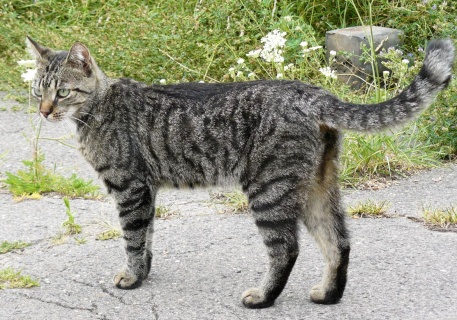Coyote (Canis latrans)

Manfred Werner via Wikimedia
Before increased human settlement led to the decline of California’s mountain lions and grizzly bears, coyotes were predominately found in the deserts and grasslands of North America. The elimination of competition from larger carnivores, lead to the widespread habitat that coyotes now enjoy. The coyote’s presence in the Baldwin Hills area is tied to animal travel corridor widths, natural vegetation and habitat size. Within the context of the Baldwin hills, the coyotes are able to supplement its diet with garbage, fruit, pet food, and the occasional domestic animal.
Mesocarnivores
Mesocarnivores are the little guys, the small or medium sized carnivores that see an increase in population when the larger carnivores (coyotes, grizzlies and mountain lions) are absent. In the context of the Baldwin Hills Natural area, the mesocarnivores include both native and nonnative species that have adapted to urban and suburban habitats.
Cat (Felis catus)

Jens Nietschmann via wikimedia
The Baldwin Hills natural area is home to a substantial feral cat population. The Baldwin hills cat population is thought to be 100 times higher than the competing native predators, due to supplemental support from human food sources. The supplemental food and water facilitate a high density of cats, which poses a concern for native wildlife. Many studies indicate that unowned cats negatively affect wildlife, including reptiles, amphibians, small mammals, and birds.
Gray Fox (Urocyon cinereoargenteus)

Zoo America via wikimedia
The gray fox is a small mesocarnivore that can be found across large portions of North America. It is not picky about its diet and can adjust its behavior to many different situations so so is able to survive in urban habitat fragments. Researchers captured photographs of gray foxes living in the Baldwin hills, with the Western portion of the hills. The likely explanation for increased density in the west is the presence of dense brush and tree habitat that seems to allow for increase protection from humans, domestic dogs and coyotes.
Striped Skunk (Mephitis mephitis)

birdphotos.com via wikimedia
Striped skunks seem to thrive in fragmented habitats. The skunk has a flexible omnivorous diet, which consists of insects, frogs, earthworms, snails, mice, bird eggs, fruit, and garbage. For the striped skunk, the Baldwin hills natural area provides a range of suitable habitat that allows the species ample resources for food and their dens. While the skunks can be found foraging in most areas of the Baldwin hills, especially the turf fields where the skunks forage for local grubs, they will den in the patches of natural habitat that provide increased protection.
Raccoon (Procyon lotor)

Ken Thomas via wikimedia
Previous research suggests that raccoon populations are highly adaptable and potentially enhanced by urban settlements. Researchers found substantial raccoon populations in the Baldwin Hills, especially in the denning habitat provided by Kenneth Hahn State Recreation Area. The raccoons were also attracted to the feline feeding stations located in Culver City Park.
Virginia Opossum (Didelphis virginiana)

Drcyrus via wikimedia
New settlers to the Los Angeles basin introduced the Virginia opossum in the early 1900s. Thanks to their generalist diet, and reproductive rate by the 1940s the species became widespread throughout the state. Recent studies at the Baldwin hills found that the opossum survives throughout the area and relies on the native vegetated areas for den sites. Similar to the striped skunks the opossum has an open diet that consists of earthworms, insects, snails, fruit, bird eggs, small mammals, and garbage.


For more information:
- Mesocarnivores in the Baldwin Hills – Miguel Ordeñana and James P. Dines (2016)
- Mammals of the Baldwin Hills – James P. Dines (2001)
- Baldwin Hills Animal Life – Dave Marqua (1978)
Additional sources
- Smithsonian National Museum of Natural History – Coyote
- Smithsonian National Museum of Natural History – Gray Fox
- Smithsonian National Museum of Natural History – Striped Skunk
- Smithsonian National Museum of Natural History – Raccoon
- Smithsonian National Museum of Natural History – Virginia Opossum
- National Geographic – Cat

